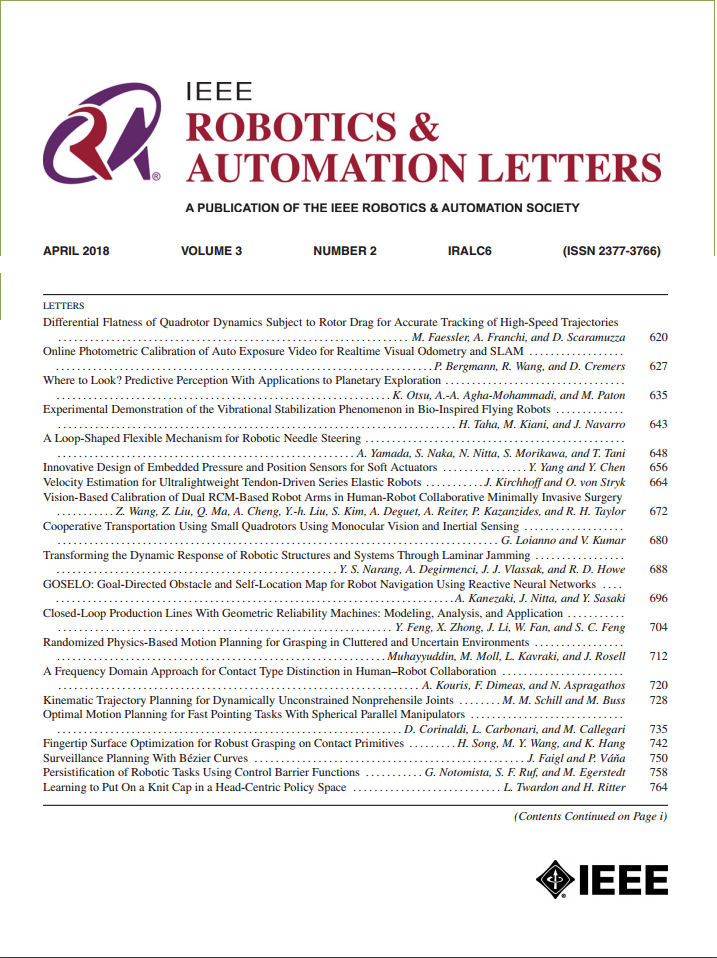Enhanced Probabilistic Collision Detection for Motion Planning Under Sensing Uncertainty
IF 5.3
2区 计算机科学
Q2 ROBOTICS
引用次数: 0
Abstract
Probabilistic collision detection (PCD) is essential in motion planning for robots operating in unstructured environments, where considering sensing uncertainty helps prevent damage. Existing PCD methods mainly use simplified geometric models and address only position estimation errors. This paper presents an enhanced PCD method with two key advancements: (a) using superquadrics for more accurate shape approximation and (b) accounting for both position and orientation estimation errors to improve robustness under sensing uncertainty. Our method first computes an enlarged surface for each object that encapsulates its observed rotated copies, thereby addressing the orientation estimation errors. Then, the collision probability is formulated as a chance-constraint problem that is solved with a tight upper bound. Both steps leverage the recently developed closed-form normal parameterized surface expression of superquadrics. Results show that our PCD method is twice as close to the Monte Carlo sampled baseline as the best existing PCD method and reduces path length by 30% and planning time by 37%, respectively. A Real2Sim2Real pipeline further validates the importance of considering orientation estimation errors, showing that the collision probability of executing the planned path is only 2%, compared to 9% and 29% when considering only position estimation errors or no errors at all.感知不确定性下运动规划的增强概率碰撞检测
概率碰撞检测(PCD)对于在非结构化环境中操作的机器人的运动规划至关重要,其中考虑感知不确定性有助于防止损坏。现有的PCD方法主要使用简化的几何模型,并且只处理位置估计误差。本文提出了一种改进的PCD方法,其中有两个关键的进步:(a)使用超二次曲面进行更精确的形状逼近;(b)同时考虑位置和方向估计误差,以提高感知不确定性下的鲁棒性。我们的方法首先为每个物体计算一个放大的表面,封装其观察到的旋转副本,从而解决方向估计误差。然后,将碰撞概率表述为一个紧上界求解的机会约束问题。这两个步骤都利用了最近开发的超二次曲面的封闭形式正规参数化曲面表达式。结果表明,我们的PCD方法与蒙特卡罗采样基线的接近程度是现有最佳PCD方法的两倍,路径长度和规划时间分别缩短了30%和37%。Real2Sim2Real管道进一步验证了考虑方向估计误差的重要性,显示执行规划路径的碰撞概率仅为2%,而仅考虑位置估计误差或根本没有误差时的碰撞概率分别为9%和29%。
本文章由计算机程序翻译,如有差异,请以英文原文为准。
求助全文
约1分钟内获得全文
求助全文
来源期刊

IEEE Robotics and Automation Letters
Computer Science-Computer Science Applications
CiteScore
9.60
自引率
15.40%
发文量
1428
期刊介绍:
The scope of this journal is to publish peer-reviewed articles that provide a timely and concise account of innovative research ideas and application results, reporting significant theoretical findings and application case studies in areas of robotics and automation.
 求助内容:
求助内容: 应助结果提醒方式:
应助结果提醒方式:


